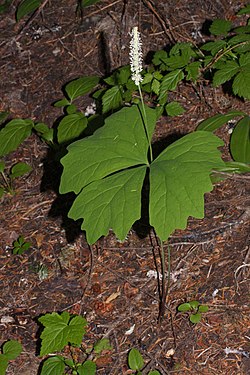| Achlys | |
|---|---|
 | |
| Achlys triphylla (Mount Rainier National Park) | |
| Scientific classification | |
| Kingdom: | Plantae |
| Clade: | Tracheophytes |
| Clade: | Angiosperms |
| Clade: | Eudicots |
| Order: | Ranunculales |
| Family: | Berberidaceae |
| Genus: | Achlys DC. |
| Type species | |
| Achlys triphylla | |
Achlys is a small genus of flowering plants in the barberry family (Berberidaceae), which it shares with genera such as Berberis and Vancouveria . [1] It is named after the Greek legendary figure associated with shade and mist, Achlys, because the plants grow in the shade. [2] [3]





